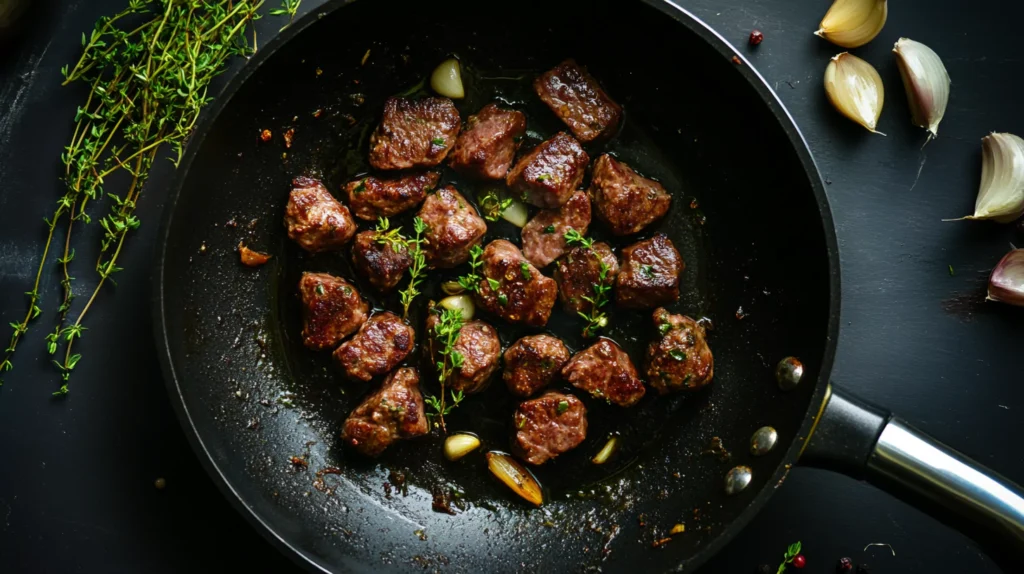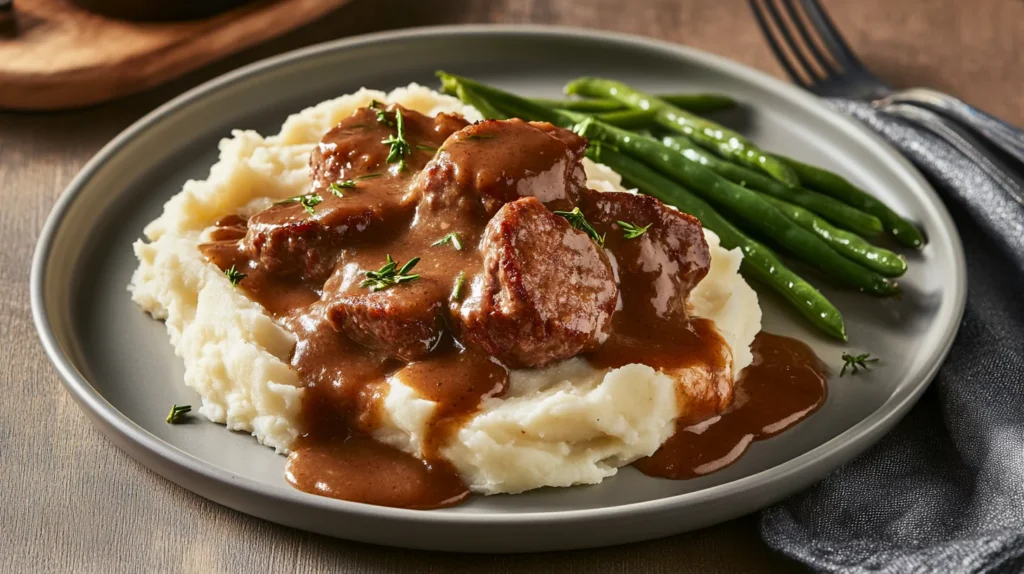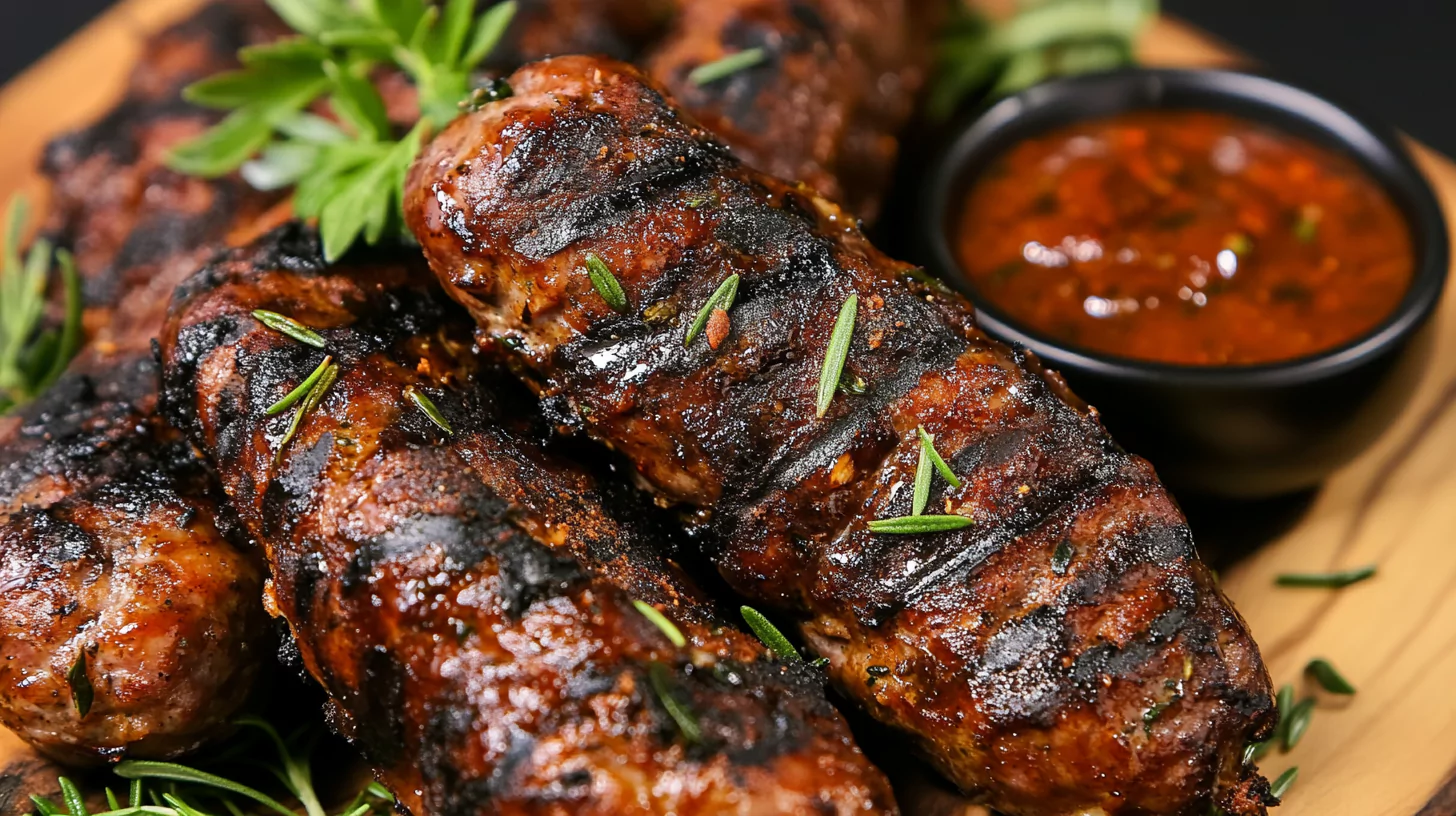The best way to cook beef sausages depends on your desired flavor, texture, and convenience. Whether you’re grilling, frying, baking, or slow-cooking, beef sausages are a versatile ingredient that can transform any meal. Known for their juicy texture and rich flavor, these protein-packed delights are perfect for breakfast, lunch, or dinner. With so many cooking methods to choose from, mastering the art of preparing beef sausages ensures a delicious result every time.
But what is the best way to cook beef sausages? The answer depends on your desired flavor, texture, and cooking convenience. Each cooking method brings out unique qualities in beef sausages—whether it’s the smoky char from grilling, the crispy skin from pan-frying, or the tenderness achieved through slow cooking.
In this article, we’ll delve into the different ways to cook beef sausages to perfection. From preparation tips to mastering each method, you’ll discover how to elevate your sausage-cooking game for delicious results every time. Whether you’re a beginner or a seasoned cook, this guide will help you unlock the full potential of this classic protein. For more inspiration, check out these delicious beef sausage recipes to complement your cooking methods.
Understanding Beef Sausages and Preparation Before Cooking
Different Types of Beef Sausages
Beef sausages come in a variety of styles, each offering distinct flavors and textures. Some popular types include:
- Traditional Beef Sausages – Often seasoned with herbs, salt, and pepper, these are classic options for breakfast or dinner.
- Spiced Beef Sausages – Infused with paprika, cumin, or chili flakes, these sausages bring a bold, zesty kick.
- Smoked Beef Sausages – Perfect for grilling, these sausages are pre-smoked for a savory depth of flavor.
- Beef and Cheese Sausages – These include chunks of cheese for a creamy burst in every bite.
- Beef Sausages with Fillers – Often mixed with breadcrumbs, rice, or vegetables to create a unique texture.
Understanding the type of sausage you’re cooking helps determine the best method to bring out its flavor while ensuring it remains juicy.
Nutritional Benefits of Beef Sausages
Beef sausages are a rich source of protein, essential for building and repairing muscles. They also provide essential nutrients like iron, zinc, and B vitamins. However, because sausages can be high in fat and sodium, choosing leaner options or controlling portion sizes is key to maintaining a balanced diet.
Factors to Consider When Choosing Beef Sausages
When selecting beef sausages, pay attention to:
- Quality: Opt for sausages made from grass-fed or organic beef for better flavor and fewer additives.
- Ingredients: Check the label to avoid unnecessary fillers or preservatives.
- Freshness: If possible, buy fresh sausages from a trusted butcher for the best results.
Preparation Before Cooking
Thawing Frozen Sausages
If your sausages are frozen, it’s crucial to thaw them properly before cooking to ensure even heat distribution. The safest way is to transfer them from the freezer to the fridge and let them defrost overnight. For a quicker method, place them in a sealed bag and submerge them in cold water.
Seasoning or Marinating
Most beef sausages are pre-seasoned, but you can enhance their flavor further with marinades or spices. For example:
- Marinade Options: Use a mix of olive oil, garlic, and rosemary for a Mediterranean flair.
- Dry Rubs: Sprinkle paprika, black pepper, or garlic powder for extra depth.
- Glazes: Brush sausages with honey or barbecue sauce for a sweet, caramelized coating during cooking.
Selecting the Right Cooking Utensils
The tools you use can significantly impact the outcome. Use:
- Non-Stick Pans: For pan-frying to prevent sticking and burning.
- Grill Racks: For outdoor or indoor grilling, ensuring even char marks.
- Baking Trays: When opting for oven baking, use a wire rack for better airflow.
Puncturing Sausages – Yes or No?
A common debate among cooks is whether to puncture sausages before cooking. While some believe it releases excess fat, others argue it causes sausages to lose their juiciness. The best approach? Avoid puncturing them to keep the flavors locked in and prevent drying out.
Best Cooking Methods for Beef Sausages
Beef sausages are incredibly versatile and can be cooked using several methods, each offering distinct results. Below, we explore the most effective ways to prepare beef sausages to achieve optimal flavor and texture.
Pan-Frying Beef Sausages
Pan-frying is one of the quickest and most popular ways to cook beef sausages. This method gives the sausages a beautifully crispy outer layer while maintaining a juicy interior.

Step-by-Step Guide to Pan-Frying:
- Preheat the Pan: Use a non-stick or cast-iron skillet and heat it over medium heat. Add a small amount of oil or butter to prevent sticking.
- Place the Sausages: Lay the sausages in the pan, ensuring they do not touch for even cooking.
- Cook Slowly: Start on medium heat and let the sausages cook gently. Avoid high heat, which can cause the casing to burn before the inside is cooked.
- Turn Frequently: Use tongs to rotate the sausages every 2-3 minutes, allowing all sides to brown evenly.
- Check for Doneness: Beef sausages should reach an internal temperature of 160°F (71°C).
Pro Tip: For extra flavor, add sliced onions, garlic, or peppers to the pan and sauté alongside the sausages.
Grilling Beef Sausages
Grilling imparts a smoky, charred flavor that enhances the natural taste of beef sausages. This method is ideal for barbecues or outdoor cooking.
Steps for Perfectly Grilled Sausages:
- Preheat the Grill: Heat your grill to medium heat. Clean the grates and brush them with oil to prevent sticking.
- Prepare the Sausages: Brush the sausages with a light coating of oil or marinade.
- Cook on Indirect Heat: Start by placing the sausages on the cooler part of the grill to allow them to cook through without burning.
- Finish with Direct Heat: Move the sausages to the hotter side for a few minutes to achieve grill marks and a crisp exterior.
- Monitor the Temperature: Use a meat thermometer to ensure the sausages reach an internal temperature of 160°F (71°C).
Grilling Tips:
- Avoid piercing the sausages, as this releases the juices and dries them out.
- If grilling pre-cooked sausages, reduce the cooking time and focus on reheating evenly.
Baking Beef Sausages in the Oven
Baking is a hands-off, healthier way to cook beef sausages, especially when preparing larger quantities.
How to Bake Sausages in the Oven:
- Preheat the Oven: Set your oven to 375°F (190°C).
- Prepare a Baking Tray: Line the tray with parchment paper or use a wire rack to allow fat to drip away during cooking.
- Arrange the Sausages: Space the sausages evenly on the tray. Avoid overcrowding, as this prevents proper browning.
- Bake and Turn: Cook for 20-25 minutes, turning halfway through to brown both sides.
- Check Doneness: Use a thermometer to confirm the internal temperature reaches 160°F (71°C).
Why Choose Baking?
Baking ensures even cooking without constant attention. It’s also a great option for minimizing added fats, as the excess grease drains away naturally.
Boiling Beef Sausages
Boiling is a gentle method that helps preserve the natural flavors of beef sausages while keeping them tender.
Steps to Boil Beef Sausages:
- Prepare the Pot: Fill a pot with water or broth and bring it to a gentle boil. For added flavor, toss in aromatics like garlic, bay leaves, or herbs.
- Add the Sausages: Place the sausages in the boiling liquid and reduce the heat to a simmer.
- Simmer Gently: Cook the sausages for 10-15 minutes, depending on their size.
- Finish with Another Method (Optional): For extra crispiness, you can quickly pan-fry or grill the sausages after boiling.
Pro Tip: Boiling is an excellent way to pre-cook sausages before finishing them on the grill or pan, ensuring they are cooked through without drying out.
Slow Cooking Beef Sausages
Slow cooking allows sausages to absorb the flavors of other ingredients, making it perfect for stews, casseroles, or soups.
How to Slow Cook Beef Sausages:
- Prepare the Ingredients: Combine sausages with vegetables like onions, carrots, and potatoes. Add liquids such as broth, tomato sauce, or wine.
- Set the Slow Cooker: Cook on low for 6-8 hours or on high for 3-4 hours.
- Check the Texture: The sausages should be tender and infused with the surrounding flavors.
Advantages of Slow Cooking:
- Ideal for batch cooking.
- A low-effort method for preparing hearty meals.
Common Mistakes to Avoid and Flavor Enhancements
While cooking beef sausages seems straightforward, certain missteps can lead to disappointing results. Here are the most common mistakes and how to avoid them:
Overcooking or Undercooking
One of the most frequent errors is not cooking sausages to the correct internal temperature.
- Overcooking: Cooking sausages for too long, especially at high heat, can dry them out and cause the casing to become tough or even burnt.
- Undercooking: On the other hand, undercooked sausages can pose a health risk. Always check that the internal temperature reaches 160°F (71°C).
Solution: Use a meat thermometer to monitor doneness accurately, and cook sausages slowly to ensure the interior cooks evenly without scorching the outside.
Puncturing the Sausage Casing
Many believe puncturing sausages prevents them from bursting during cooking. However, this causes the juices to escape, leaving them dry and less flavorful.
- Solution: Cook sausages gently and avoid high heat initially to prevent bursting without puncturing the casing.
Using Too Much Oil
Sausages already contain a significant amount of fat, so adding excessive oil can make them greasy.
- Solution: Use minimal oil, especially for pan-frying or grilling. If baking, a lined tray ensures any excess fat drains off.
Rushing the Cooking Process
Cooking sausages on high heat in a rush often leads to uneven cooking, with a burnt exterior and raw interior.
- Solution: Always start at medium to low heat and allow the sausages to cook through gradually.
Flavor Enhancements for Beef Sausages
The beauty of beef sausages lies in their ability to pair well with a variety of spices, marinades, and condiments. Below are ideas to elevate the flavor of your sausages:
Adding Marinades or Glazes
A good marinade can enhance the taste of sausages, while a glaze adds a delicious finishing touch.
- Marinades: Soak sausages in a mixture of soy sauce, garlic, and honey for a sweet-savory flavor.
- Glazes: Brush sausages with barbecue sauce or mustard-honey glaze during the last few minutes of cooking for a caramelized finish.
Pro Tip: Avoid marinating sausages with high-acid ingredients like vinegar for too long, as it can break down the casing.
Incorporating Spices and Herbs
For extra flavor, consider adding fresh or dried herbs and spices during cooking. Popular choices include:
- Paprika, chili powder, or black pepper for a spicy kick.
- Thyme, rosemary, or sage for a herbaceous touch.
- Garlic and onion powder for a savory boost.
Pro Tip: Add herbs and spices to the pan while frying or baking sausages to infuse the cooking oil with their aroma.
Serving with Sauces and Condiments
Beef sausages taste even better when paired with the right condiments. Some options include:
- Classic Pairings: Ketchup, mustard, and mayonnaise.
- Bold Flavors: Hot sauce, chutneys, or horseradish.
- Creamy Sauces: Cheese sauce, béchamel, or garlic aioli.
Pro Tip: Serve sauces on the side to allow customization, especially when cooking for a group.
Experimenting with Toppings and Additions
Enhance the texture and taste of sausages by adding toppings like:
- Caramelized onions for sweetness.
- Sautéed mushrooms for an earthy flavor.
- Crispy bacon bits or melted cheese for indulgence.
Serving Ideas, Storage, and Health Tips
Beef sausages can be served in countless ways, making them a versatile choice for any meal. Here are some creative ideas to inspire your next dish:

Classic Serving Ideas
- Breakfast Delight: Serve sausages alongside scrambled eggs, crispy hash browns, and buttered toast for a hearty breakfast.
- Barbecue Favorite: Pair grilled sausages with coleslaw, baked beans, and corn on the cob for a backyard feast.
- Comfort Food: Add sausages to creamy mashed potatoes with a side of rich onion gravy for a comforting meal.
International-Inspired Dishes
- Italian Style: Toss sliced beef sausages with marinara sauce and pasta, topped with grated Parmesan cheese.
- German Plate: Serve sausages with sauerkraut, mustard, and soft pretzels for a Bavarian-style meal.
- Mexican Twist: Use sausages as a filling for tacos or burritos, combined with salsa, guacamole, and shredded cheese.
Side Dish Pairings
Beef sausages pair beautifully with a wide range of sides, from light salads to hearty carbs. Popular options include:
- Vegetable Sides: Roasted Brussels sprouts, sautéed spinach, or a fresh garden salad.
- Starchy Sides: Rice pilaf, baked sweet potatoes, or garlic bread.
- Comfort Sides: Creamy mac and cheese or cheesy potato gratin.
Pro Tip: For a balanced meal, pair sausages with a mix of proteins, vegetables, and carbs.
Innovative Serving Ideas
- Skewers: Thread sausages onto skewers with bell peppers, onions, and cherry tomatoes for a fun appetizer.
- Stuffed Dishes: Use sausages to fill baked bell peppers or hollowed-out zucchini boats.
- Casseroles: Slice sausages into bite-sized pieces and add them to a baked casserole with potatoes, cheese, and cream.
Storage and Reheating Tips
Properly storing and reheating beef sausages is essential to maintain their flavor and safety.
Storing Cooked Sausages
- Refrigeration: Place cooked sausages in an airtight container and refrigerate for up to 3-4 days.
- Freezing: Wrap sausages in foil or freezer-safe bags, and store them in the freezer for up to 2-3 months. Label the package with the date for easy tracking.
Reheating Cooked Sausages
- In the Oven: Preheat the oven to 350°F (175°C) and reheat sausages on a baking tray for 10-15 minutes.
- On the Stove: Slice sausages into smaller pieces and heat them in a skillet with a small amount of oil.
- In the Microwave: Place sausages in a microwave-safe dish, cover with a damp paper towel, and heat in 30-second intervals.
Pro Tip: Avoid reheating sausages multiple times, as this can dry them out and compromise their texture.
Health and Safety Tips
Ensuring that beef sausages are cooked safely is vital for preventing foodborne illnesses.
Cooking to the Right Temperature
Always ensure sausages reach an internal temperature of 160°F (71°C) to eliminate harmful bacteria. Use a meat thermometer for accuracy.
Avoiding Cross-Contamination
- Wash your hands and utensils thoroughly after handling raw sausages.
- Use separate cutting boards for raw meat and other ingredients.
Controlling Portion Sizes
Beef sausages can be high in fat and sodium, so it’s important to enjoy them in moderation. Pair them with nutrient-dense sides like vegetables and whole grains for a balanced meal.
Frequently Asked Questions and Conclusion
Can I cook beef sausages straight from frozen?
Yes, you can cook beef sausages directly from frozen, but it will require a longer cooking time. If pan-frying or grilling, cook on low to medium heat to ensure the inside cooks thoroughly without burning the exterior. For a safer and even cook, it’s better to thaw them in the refrigerator overnight before cooking.
How do I know when my beef sausages are fully cooked?
The most reliable way to check is by using a meat thermometer. The internal temperature should reach 160°F (71°C). Additionally, the sausages should be firm to the touch, and any juices running from them should be clear, not pink.
Why do my sausages burst while cooking?
Sausages burst when they are exposed to high heat too quickly, causing the casing to split. To prevent this, cook them slowly over medium or low heat and avoid piercing the casing.
Can I bake sausages without oil?
Yes, you can bake sausages without oil, especially if they are high in fat. Place them on a wire rack over a lined baking tray to allow the fat to drip away. This method ensures a healthier, evenly cooked sausage.
Are beef sausages healthy?
Beef sausages can be part of a healthy diet when eaten in moderation. Look for sausages with minimal fillers and preservatives, and pair them with nutrient-dense sides like vegetables and whole grains. Opt for leaner sausage varieties to reduce fat and sodium intake.
Can I cook beef sausages in an air fryer?
Absolutely! Air fryers are an excellent way to cook beef sausages, offering a quick and healthier option. Preheat the air fryer to 375°F (190°C), place the sausages in the basket without overcrowding, and cook for 10-15 minutes, turning halfway through for even browning.
Conclusion
Cooking beef sausages to perfection requires attention to detail and an understanding of the method that best suits your needs. Whether you’re pan-frying for a crispy texture, grilling for smoky flavors, or baking for a healthier alternative, each technique brings out unique qualities in these flavorful proteins.
By avoiding common mistakes like overcooking or piercing the casing, and by experimenting with marinades, spices, and creative serving ideas, you can elevate your beef sausage dishes to a new level of deliciousness. Don’t forget to prioritize health and safety, ensuring proper cooking temperatures and mindful storage of leftovers.
Beef sausages are a versatile and satisfying ingredient that can shine as a breakfast staple, a barbecue star, or the centerpiece of a comforting dinner. With the tips and methods outlined in this guide, you’re now equipped to make the most of these savory delights, turning them into memorable meals every time.


1 thought on “Best Way to Cook Beef Sausages: Tips for Perfect Flavor”